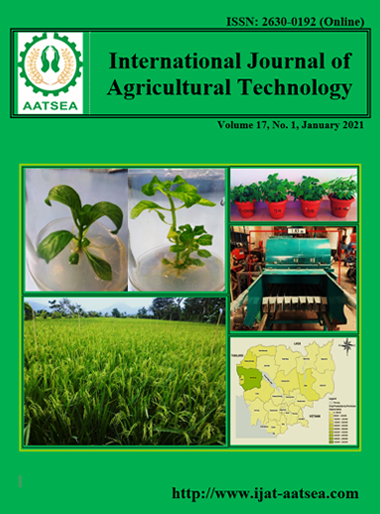Characteristics of red macroalgae, Caloglossa beccarii DeToni from freshwater for food as safe and other applications in Thailand
Main Article Content
Abstract
Caloglossa beccarii DeToni is a freshwater red algae which contains dark brown filament and lives on surface of rocks at the bottom of shallow stream in different parts of Thailand, especially, in the southern region. The acute toxicity, nutritional value, antioxidant activity and phytochemical properties for high potential edible alga were reported. Acute toxicity was examined with a single oral administration of the extract at a dose of 2 and 5 g.kg-1 body weight. Mortality, behavior, body weight, total food intake, and any abnormalities presented in visceral organs, were observed. The extract resulted in no mortality or abnormalities. Among proximate analysis, the algae were rich in mineral (calcium, potassium, manganese, iron and magnesium), carbohydrate (fiber and polysaccharide) and protein (arginine and leucine). It also offered a high level of vitamin C and linolenic acid. The antioxidant activities were shown in all extracts. The highest TPC, DPPH and ABTS activities were in aqueous (20.868 ± 0.68 mgGAE.g extract-1), methanolic (IC50 = 0.086±0.01 mg.mL-1) and ethanolic extract (IC50 = 0.178 ± 0.01 mg.mL-1). A potential source of phycocyanin and phycoerythrin was shown. These results indicated that C.beccarii contains various bioactive compounds which are safe with useful characters
Article Details

This work is licensed under a Creative Commons Attribution-NonCommercial-NoDerivatives 4.0 International License.
References
Amornlerdpison, D., Ngernjan, M., Mengumphan, K. and Junthin, R. (2016). Active compounds and oxidative defense of Cladophora spp. in hybrid catfish. KMUTT Research & Development Journal, 38:393-405.
AOAC (2000). Association of Official Analytical Chemists 14th Association Official Analytical Chemists, Washington D.C.
Bennet, A. and Bogorad, L. (1973). Complementary chromatic adaptation in a filamentous blue-green alga. Journal of Cell Biology, 58:419-435.
Bryant, D. A., Guglielmi, G., de Marsac, N. T., Castets, A. and Cohen, B. G. (1979). The structure of cyanobacterial phycobilisomes: a model. Archives of Micribiology, 123:113-127.
Chew, Y. L., Lim, Y. Y., Omar, M. and Khoo, K. S. (2008). Antioxidant activity of three edible seaweeds from two areas in South East Asia. LWT - Food Science and Technology, 41:1067-1072.
de Quirós, A. R. and Costa, H. S. (2006). Analysis of carotenoids in vegetable and plasma samples: A review. Journal of Food Composition and Analysis, 19:97-111.
Gabriela, G. S., Luis, F. C. and German, C. C. (2015). Nutritional and toxicological aspects of Spirulina (Arthrospira). Nutrición Hospitalaria, 32:34-40.
Laungsuwan, R. and Chulalaksananukul, W. (2013). Antioxidation and anticancer activities of freshwater green algae, Microspora floccosa and Cladophora glomerata, from Nan River in Northern Thailand. Maejo International Journal of Science and Technology, 7:181-188.
Lopez, A., Rico, M., Rivero, A. and Tang, M. S. (2011). The effects solvents on the phenolic contents and antioxidant activity of Stypocaulon scoparium algae extracts. Food Chemistry, 125:1104-1109.
Kamiya, M. and West, J. A. (2014). Cryptic diversity in the euryhaline red alga Caloglossa ogasawaraensis (Delesseriaceae, Ceramiales). Phycologia, 53:374-382.
Kumano, S. (2002). Freshwater red Algae of world. Biopress Limited, Bristol, England.
Manach, C. A., Scalbert, C., Morand, R. C. and Jiménez, L. (2004). Polyphenols: Food sources and bioavailability. The American Journal of Clinical Nutrition, 79:727-747.
McHugh, D. J. (2003). A guide to the seaweed industry. Fisheries Technical paper 441. FAO. Rome, Italy.
Necchi, Jr. O. (2016). Red algae (Rhodophyta) in river p.65-105 In River algae. Necchi, Jr. O. (editor). Springer.
OECD (1998). Harmonized integrated hazard classification system for human health and environmental effects of chemical substances. Organization for economic co-operation and development, France.
OECD (2001). Guidelines for the testing of Chemicals: 425 adopted 17th December: Acute oral toxicity-up-down procedure, OECD. Paris.
Ouellette, J. A. and Wilhelm, S. W. (2003). Toxic cyanobacteria: the evolving molecular toolbox. Frontiers in Ecology and the Environment, 1:359-366.
Peerapornpisal, Y., Nualcharoen, M., Suphan, S., Kunpradid, T., Inthasotti, T., Mungmai, R., Dhitisudh, L., Sukchotiratana, M. and Kumano, S. (2006a). Diversity and habitat characteristics of freshwater red algae (Rhodophytes) in some water resources of Thailand. ScienceAsia, 32:63-70.
Peerapornpisal, Y., Amornlerdpison, D. Rukiamawate, C., Ruangrit, K. and Kanjanapothi, D. (2006b). Two edemic species of macrolagae in Nan river, Northern Thailand as therapeutic agent. Science Asia, 1(Supplement):71-76.
Punyoyai, T. (2007). Antioxidant activity of Tao, Spirogyra neclecta (Hassall) HṺtzing. Dissertation. Chiang Mai University.
Re, R., Pellegrini, N., Proteggente, A., Pannal, A., Yang, M. and Rice-Evan, C. (1999). Antioxidant activity applying an improved ABTS radical cation decolorisation assay. Free Radical Biology and Medicine, 26:1231-1237.
Sato, H. and Akiyama, H. (2001). Caloglossa beccarii (Ceramiales, Rhodophyta) from Thailand on the Malay Peninsula and its distribution in Southeast Asia. Nature and Human Activities, 6:101-104.
Shalaby, E. A. (2015). Algae as a natural source of antioxidant active compounds p.129-147, In: Plants as a source of natural antioxidants, Banaras Hindu University, India.
Shimada, K., Fujikawa, K., Yahara, K. and Nakamura, T. (1992). Antioxidative properties of xanthanon on the autoxidation of soybean oil in cyclodextrin emulsion. Journal of Agricultural and Food Chemistry, 40:945-948.
Shon, M. Y., Kim, T. M. and Sung, N. J. (2003). Antioxidants and free radical scavenging activity of Phellinus baumii (Phellinus of Hymenochaetoceae) extracts. Food chemistry, 82:593-597.
Thiamdao, S. and Peerapornpisal, Y. (2009). Diversity of edible freshwater Macroalgae in Mekong and Nan rivers. Journal of Fisheries Technology Research, 3:115-124.
Thiamdao, S., Motham, M., Pekken, J., Mungmai, L. and Peerapornpisal, Y. (2012). Nostochopsis lobatus Wood em.Geitler (Nostocales), edible algae in northern Thailand. Chiang Mai Journal of Science, 39:119-127.
Yucharoen, R., Srisuksomwong, P. and Tragoolpua, Y. (2015). Antibacterial and antioxidant activities of Nostoc commune Vaucher et Bornet et Flahault. Science &Technology RUMTT Journal, 5:35-48.


